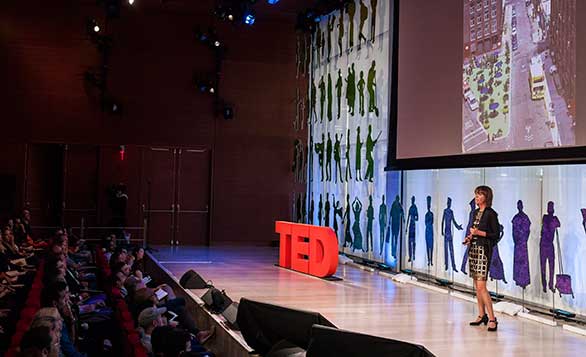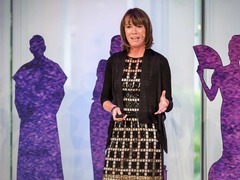
The commissioner of New York’s Department of Transportation, Janette Sadik-Khan, shares the story of transforming New York’s streets at TEDCity2.0. Photo: Ryan Lash
“It doesn’t need to be a zero-sum game between moving traffic and creating public space,” says Janette Sadik-Khan in today’s TED Talk, filmed at TEDCity2.0 earlier this month.
 Janette Sadik-Khan: New York's streets? Not so mean any more
Sadik-Khan tells the story of how she and her team — quickly and cheaply, but not without controversy — changed New York from a city designed for car transit to a city where bikes, pedestrians and drivers all move in sync.
Janette Sadik-Khan: New York's streets? Not so mean any more
Sadik-Khan tells the story of how she and her team — quickly and cheaply, but not without controversy — changed New York from a city designed for car transit to a city where bikes, pedestrians and drivers all move in sync.
Since 2007, when she was named commissioner of the city’s Department of Transportation, DOT’s urban transport programs have quickly and inexpensively remade the streets around the five boroughs of New York, creating pedestrian plazas and hundreds of miles of bike lanes, jump-starting Bus Rapid Transit and midwifing a bike-share program with 6,000 strategically placed bikes.
“You have to design your streets for everyone. The cities that have safe streets, that are easy to get around, are the ones that will grow and thrive in the 21st century,” Sadik-Khan told the TED Blog.
What inspired her bold slate of urban projects? She says: “We took pieces from lots of different cities to have the gorgeous mosaic that we have in New York.” So we asked: Which ones?
Sadik-Khan found inspiration for New York’s integrated bike lanes from Copenhagen’s urban bike paths. The Danish model incorporates bikes directly into the street, but protects bikers by floating parking lanes in the middle of traffic, creating a low-cost buffer zone that made it safer for bikers to move quickly around the city.
Copenhagen also has one of the earliest bike-share programs, which helped inspire the launch of Citi Bikes in New York this past summer. Sadik-Khan also cites Paris and London as powerful sources of inspiration. From Vélib, Paris’s six-year-old bike share program, she realized that New York’s Citi Bike program needed to be interconnected — that all of the stations needed to work in sync. In New York, like in Paris, users can return bikes to any docking station, and if one station is full, users will be directed to the nearest hub with available spaces. From London’s Barclays Cycle Hire, she got the idea for a privately funded project at no cost to taxpayers — and she also learned that flexibility would be key in New York, where the new bike-share stations are solar-powered and wireless and can be moved as demand changes. The idea of bike shares has spread rapidly from city to city — as of this week, you can rent a public bike in 525 cities around the globe.
At the same time, Bogotá’s Bus Rapid Transit system got Sadik-Khan thinking hard about how to best manage New York’s bus fleet, which is both the largest and slowest in the world. Bogotá got its buses moving by getting them out of congested city traffic and into speedier dedicated bus lanes. Inspired by the Colombian program, she introduced the Select Bus Service in 2008, using paint and lane markers to reallocate space on the streets to bus-only lanes. There are six Select Bus Service routes in New York now, with more planned.
In her talk, Sadik-Khan shares a bold idea for how to launch projects quickly and inexpensively — pilot them with temporary materials to test them out. In Times Square in May 2009, for instance, her team blocked off a brand-new pedestrian zone with “paint and orange barrels,” and filled the space with cheap lawn furniture from a local hardware store. “We were able to show how it worked,” she said. “If it worked better for traffic, if it worked better for mobility, if it was safer, better for business, we would keep it. And if it didn’t work, no harm, no foul — we could put it back the way it was, because these were temporary materials. That was a big part of the buy-in. Much less anxiety when you think something can be put back.” (Spoiler: The Times Square pedestrian zone was so beloved that the traffic-free zone was made permanent in February 2010.)
Since 2007, Sadik-Khan and her team have reallocated 26 acres of urban space for pedestrian use, building 50 plazas around New York’s five boroughs. These plazas close off under-used streets and carve out space for people on foot, creating a space for public art installations, live performances and recreation. Public plazas have made the streets safer for pedestrians and have actually sped up traffic.
This transformation has, in turn, inspired other cities — including Boston, Buenos Aires, San Francisco, Los Angeles and Mexico City — to create their own pedestrian spaces. Los Angeles, a notoriously car-centric city, carved out a corner of its Silver Lake district in 2012 for the public to walk, sit and eat. It even duplicated the green dots that mark New York’s streets. Buenos Aires is expanding its pedestrian zones to create calmer spaces in the bustling city of 12.8 million.
Sadik-Khan says she’s noticed a kind of competition among the world’s global cities, which are measuring themselves against one another. This competitiveness, she notes, urges big cities to think seriously about sustainability and innovate new ways to make their cities greener. Instagram and Tumblr push this forward, by making visual design easier to share. “Ideas are spreading like wildfire,” she says.
It’s igniting a powerful conversation about the environment and space use; together, Sadik-Khan says, these competing, inspiring cities are developing a playbook for 21st-century urban design.
Comments (8)
Pingback: Janette Sadik-Khan: New York’s streets? Not so mean any more | Ottawa Bicycle Lanes Project | Let's Create A More Liveable Ottawa
Pingback: My City: Khurram Siddiqi on how not to get lost in Lahore, Pakistan | TokNok Multi Social Blogging Solutions
Pingback: The one rule in Jack Andraka’s basement laboratory—don’t burn the house down | TokNok Multi Social Blogging Solutions
Pingback: MAGIC VIDEO HUB | More to life than DNA: Fellows Friday with Sheref Mansy
Pingback: If you liked Amy Webb, you’ll love… | TokNok Multi Social Blogging Solutions
Pingback: My City: Inaki Romero Larrea on building a better Madrid | TokNok Multi Social Blogging Solutions